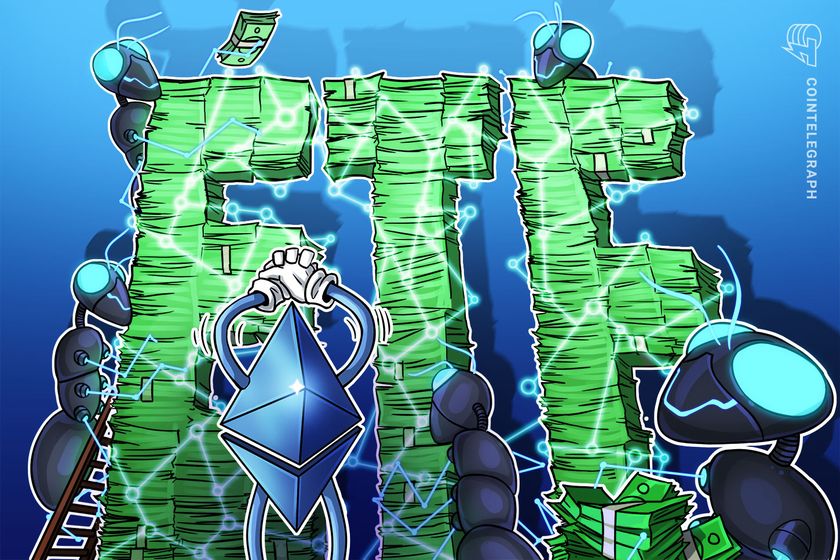Is payments giant SWIFT preparing for a blockchain-bound future?

Are TradFi and DeFi converging, moving toward a middle ground that includes tokenized assets, interoperability and regulation?
SWIFT is a payments colossus. It operates across more than 200 countries, has 11,000-plus financial institution clients and transmits some 8.4 billion financial messages every year. It is the global leader in cross-border bank-to-bank payments and recently played a key role in the West’s economic sanctions on Russia.
That doesn’t mean the Belgium-based cooperative is immune to disruption tremors, however. Critics have long maintained the interbank messaging system, founded in the 1970s, is “old, inflexible, slow, and increasingly prone to cyberattacks.” In May, Mastercard CEO Michael Miebach cast doubt upon SWIFT’s ability to survive the next five years. Meanwhile, it continues to be menaced by a rising tide of blockchain-based payment networks on one side and an expected torrent of central bank digital currencies (CBDCs) on the other.
But, last week, in a sign that even entrenched legacy financial networks can (possibly) change their stripes, SWIFT confirmed a proof-of-concept project with blockchain oracle provider Chainlink. If all goes well, SWIFT’s bank users could easily access and transfer digital assets on multiple blockchain platforms. Days earlier, SWIFT also announced it was using fintech-firm Symbiont’s enterprise blockchain platform to improve its messaging for corporate events like dividend payments and mergers.
These developments raise an intriguing question: Rather than engaging in a zero-sum struggle to the death, are traditional finance (TradFi) and decentralized finance (DeFi) firms actually converging — i.e., moving toward a common middle ground that includes tokenized assets, DeFi, interoperability and, yes, regulation?
Co-opting an existential threat?
“All financial goods will move across blockchain networks in the future,” Matthew Hougan, chief investment officer at Bitwise Asset Management, told Cointelegraph. “It’s not surprising to see legacy firms looking to adopt and/or co-opt a technology that represents a fundamental threat to their existence; in fact, it should be applauded.”
Of course, this is just a pilot program. Hougan added, “It’s not like SWIFT got blockchain religion overnight and is converting all their activities to DLT.” But, it’s a start, and for that, the network should be applauded, he suggested.
In this rapidly evolving technological world, “there is no place for binary viewpoints that embrace an ‘I win, you lose’ mentality,” especially within its capital markets and finance sector, Mark Smith, CEO and co-founder of Symbiont, told Cointelegraph, further adding:
“Ultimately what ends up being the norm is usually a hybrid, and we definitely see a melding unfolding that will borrow from the best that TradFi and DeFi have to offer.”
Jonathan Solé, strategy director at SWIFT, speaking at last week’s Smartcon 2022 convention in New York, acknowledged an “undeniable interest” on the part of institutional investors in digital assets “whether these are stablecoins, CBDCs or anything that you can tokenize on the capital markets space” including equities and bonds.
Banks and other TradFi institutions are looking to SWIFT to “bridge the gap” between their infrastructure servicers, like exchanges, custodians and clearing houses, “and all of these new blockchains that are going to provide these services” for tokenized assets, he added at a panel titled “Bridging Traditional Finance and DeFi.”
The session was moderated by Chainlink CEO Sergey Nazarov, who noted that SWIFT possessed the TradFi world’s “largest private key infrastructure,” adding:
“There is no reason to get rid of that private key infrastructure that already securely signs transactions to move around trillions of dollars in value. All of those standards can simply have an addition made to them that says: blockchain stuff.”
But, SWIFT “doesn’t necessarily want to build an integration with every single chain on the planet,” added Nazarov, which was why it was exploring Chainlink’s Cross-Chain Interoperability Protocol (CCIP) as a way for it “to become interoperable across all blockchain environments.”
Stephen Prosperi, head of product management and digital securities management of DTCC, which provides clearance and settlement services for U.S. securities markets — another TradFi heavyweight — seconded this point. Different digital currencies “will live across different chains,” and firms like DTCC don’t want to build separate infrastructure to connect to each of the 100 blockchains that host desirable digital assets. A central point of entry like CCIP could therefore be useful.
Are cross-chain bridges secure?
The Smartcon panelists didn’t really address some of the challenges associated with cross-chain bridges, however, including security concerns. “Yes, there are security risks with cross-chain projects,” commented Hougan, “which is why you need pilot projects like this.”
Cross-chain bridges are designed to solve the problem of interoperability between blockchain platforms. Blockchain networks today — Bitcoin, Ethereum, Solana and others — are like the railroad systems in the 19th century before track gauge sizes were standardized. Passengers and freight had to be offloaded to another train when incompatible rail lines met.
Cross-blockchain bridges are designed to solve these sorts of incompatibilities, but the problem is they appear to be vulnerable to hacks. Some $2 billion has been stolen from bridges in 13 separate heists, according to Chainalysis, most of it this year. Ethereum founder Vitalik Buterin, too, red-flagged cross-chain bridges recently, suggesting they can enable 51% network attacks.
A key problem seems to be that the “bridges” tend to accumulate large amounts of “locked assets” from different blockchains, some quite obscure and not always built with advanced security features, according to Elliptic’s Cross-Chain Report 2022 released Oct. 4, which noted:
“This has made bridges an attractive target for cybercriminals. […] From January to July 2022, $1.2 billion worth of cryptoassets were stolen across eight bridge compromise incidents.”
Chainlink presumably believes it will do a better job with security than cross-chain bridges have done in the past. Nazarov said as much in post-Smartcom interviews. “That is what CCIP seeks to solve. And I don’t think it’s an intractable problem. I think it’s a solvable problem,” he told Fortune.
Are traditional institutions ready for tokenization?
Apart from the need for interoperability, are there other commonalities that are bringing TradFi and blockchain providers closer together? Are the capital markets ready for tokenization, for instance, Nazarov asked panelists.
“Well, it’s definitely here. It is not going to go away,” answered Solé. “We have adopted all of our messaging standards so that we can make sure that we can cater for the information that is needed for tokenized assets.”
“We’re actually looking at tokenizing all different types of assets internally,” Victor O’Laughlen, managing director and head of enterprise tokenization at Bank of New York Mellon (BNY), told the panel. BNY’s broker-dealer and investment manager clients “don’t want to segregate and manage their assets in different pools. They want to have one client experience.” Another attraction of blockchain-enabled tokenized assets is that they are accessible 24/7. O’Laughlen added:
“It’s the infrastructure that always stays up, right? The crypto markets have really pushed the financial markets to think about that. And, we need to be able to support our clients at any time zone, in any location.”
Beyond interoperability and tokenization, there was some interest among the TradFi representatives in DeFi projects proper — but with caveats. “If financial services want to go into DeFi mode, there needs to be some sort of regulated DeFi,” said Solé, though some might view that as a contradiction in terms.
Prosperi echoed the need for a sort of “permissioned DeFi,” one that had compliance baked in. “At the end of the day, institutions need to feel like they’re not going to get busted on KYC, AML — that they know who they’re transacting with.”
BNY Mellon’s O’Laughlen saw some positives with DeFi protocols, though. “DeFi could benefit intraday liquidity, where liquidity is needed to sort of grease the wheels.” Institutions could begin with lending or borrowing assets or cash, as “some of the more vanilla types of [DeFi] transactions that take place between counterparties and financial institutions would be a great first step.”
A boost to crypto adoption
Finally, what, if anything, does all this have to do with crypto/blockchain adoption? Ecumenical panel discussions like what occurred at Smartcon are encouraging, but will partnerships like SWIFT-Chainlink really “accelerate the adoption of DLT blockchains and benefit various institutions all over the capital markets,” as Nazarov suggested?
“It’s positive news,” Hougan told Cointelegraph. “Every time an entrenched incumbent recognizes that it has to think about the implications of blockchain technology, it makes it easier for the next one to do so. This is another brick in the wall.”
“Chainlink has a strong competitive position in providing oracles and trustless data sources, and it grows by integrating those tools into more capital markets and payments networks,” Lex Sokolin, head economist at ConsenSys, told Cointelegraph. “The purposes of blockchains are different and varied. Generally, I do think more integration implies more paths to adoption.”
Smith, for his part, sees a “real maturation” of blockchain technology across financial services, viewing it as the “connective tissue” that will make both TradFi and DeFi successful. Blockchain technology was created originally to provide a better bank payment system, and 13 years later, it “continues to become more widely accepted and adopted among banks, asset managers and global markets,” Smith said.









